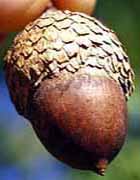| Quercus kelloggii | |
| Author | Newb. 1859 Pacif. Railr. Rep. Williamson, Bot. 6: 28, 89 |
| Synonyms | californica
(Torr.) Cooper 1858 sonomensis Benth. ex A.DC 1864 tinctoria W. Bartram var. californica Torr. 1857 |
| Local names | California
black oak |
| Range | SW Oregon, California,
Sierra Nevada ; to 2400 m; introduced in Europe in 1878; |
| Growth habit | reached 25 m,
but is a 5 m tall shrub at high elevations; ascending branches; roundes
crown, stout trunk; |
| Leaves | 7.5-20 x 5-13
cm; thick, leathery; apex pointed, base obtuse or cordate; margin deeply
7-11 lobed; toothed lobes (13-30 bristled teeth); lustrous green, hairless
above; paler beneath with some stellate hairs at vein axils; veins raised
on both sides; petiole 1-5 cm long, sometimes pubescent; |
| Flowers | March to May; male flowers on 4-7.5 cm long catkins; female 1 to 6 together; |
| Fruits | acorn 2-3 cm;
elliptic; brown, puberulent near apex; very short stalk, or almost sessile;
deep cup enclosing 1/2-2/3 of nut, with pale brown, flat, papery, over
4 mm long scales; maturing in 2 years; edible; |
|
Bark, twigs and |
bark
at first grey brown and smooth, becoming dark, rough, furrowed; twigs
brown, glabrescent, 2-3.5 cm in diameter; terminal bud brown, ovoid, glabrous
or with ciliate margin scales, 4-10 mm long; |
| Hardiness zone, habitat | hardy;
all types of soils, but prefers lime-free ones; thrive in well drained
soils; slow-growing, long-lived; young plants have a low growth rate during
2-3 years; |
| Miscellaneous | --
A.Camus :n° 430; -- Sub-genus Quercus, section Lobatae, Series Agrifoliae (with agrifolia, parvula, wislizeni) -- Resembles Q.velutina ; -- Hybridizes with Q.agrifolia ( = x ganderi) and Q.wislizeni ( = x morehus) ; |
| Subspecies and varieties |
|
| Pictures |





